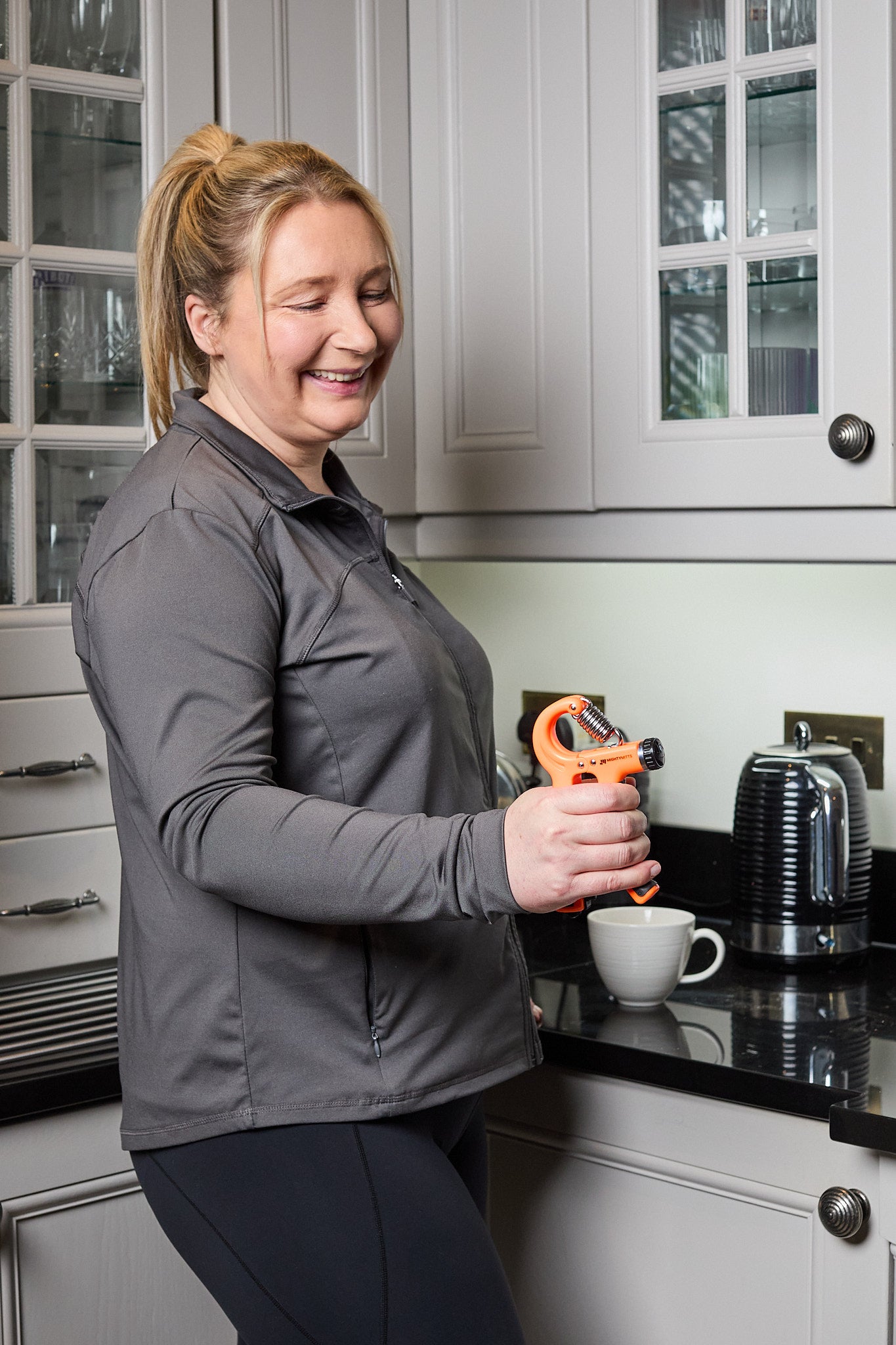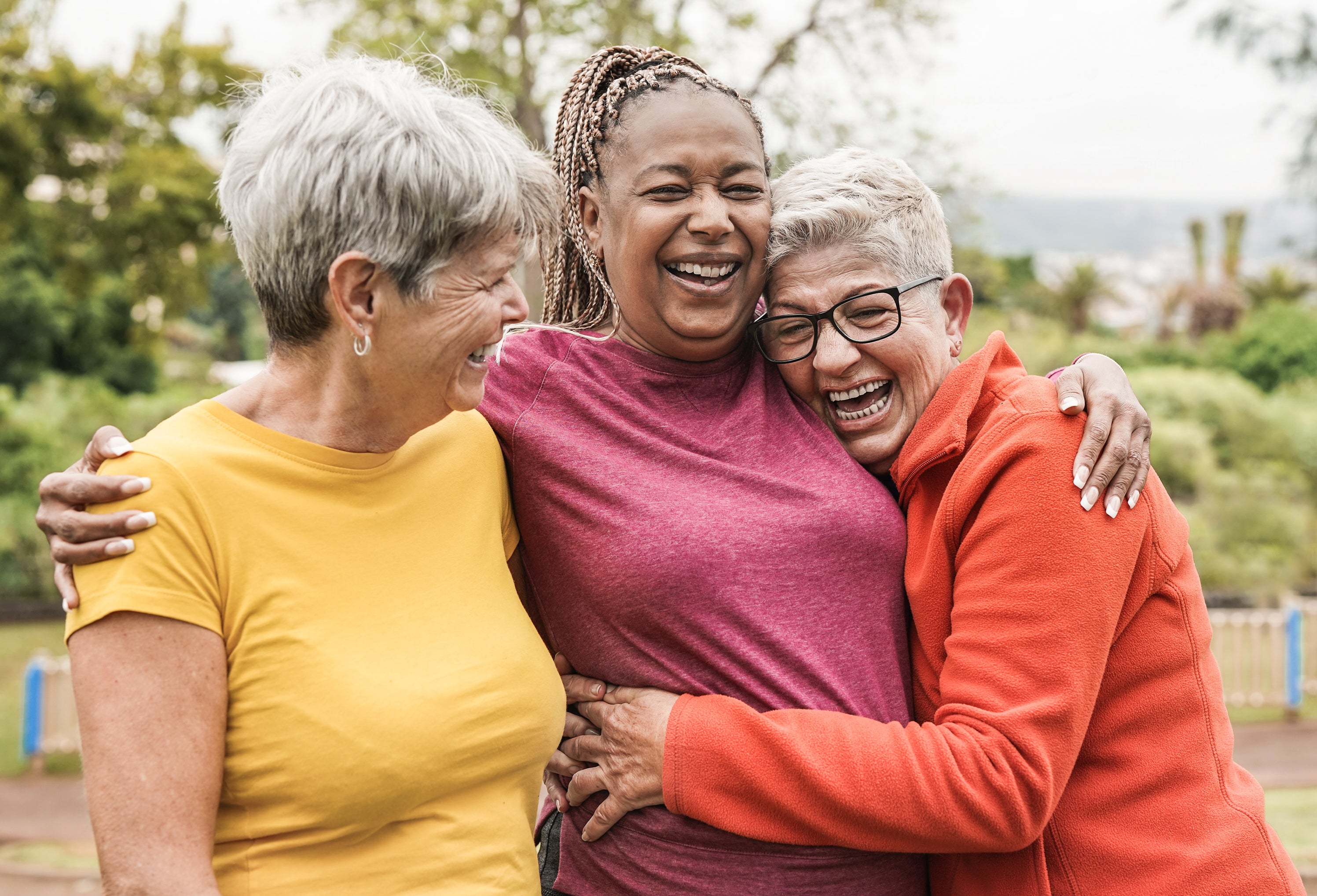What is it?
What is Menopause?
Menopause is a natural biological process marking the end of a woman's reproductive years. It is typically defined as 12 months after your last menstrual period.
Menopause is caused by a decline in the production of the hormones estrogen and progesterone by the ovaries.
Menopause is caused by a decline in the production of the hormones estrogen and progesterone by the ovaries.

The Hormone-Muscle-Grip Connection
Here's a closer look at the interplay between these factors:
Estrogen's Protective Influence:
Estrogen, a key hormone in women's health, plays a vital role in preserving muscle mass and strength. As estrogen levels naturally decline during menopause, this protective influence diminishes, making women more susceptible to muscle loss.
Grip Strength as a Vital Sign:
Your grip strength isn't merely a measure of hand strength; it serves as a valuable window into your overall muscle health. A firm grip often signifies robust muscles throughout your body, while a weakening grip can be an early indicator of muscle loss and potential functional decline.
Why Grip Strength Matters During and After Menopause
The Mighty Mitts exercise programme is rooted in the latest scientific evidence and best practices in exercise science for menopausal health. It incorporates a variety of exercises that have been scientifically proven to:
Promoting Overall Health:
Maintaining good muscle strength is vital for overall health, including bone health, metabolic health, and even cognitive function.
Preserving Independence:
Strong muscles are essential for maintaining independence and quality of life as we age. A firm grip is crucial for performing a wide range of daily tasks, from carrying supermarket bags and opening jars to navigating stairs and maintaining balance.
Reducing Fall Risk:
Sarcopenia and decreased grip strength increase the risk of falls, a leading cause of injury and disability among older adults. Prioritizing grip strength and overall muscle health can help you stay steady on your feet and reduce your risk of falls.
Early Detection and Intervention:
Grip strength testing offers a convenient and accessible method for monitoring muscle health during menopause. It can detect subtle changes in muscle function even before significant muscle loss becomes evident, enabling timely interventions to preserve strength and mobility.
Taking Charge: Strategies for Maintaining Muscle and Grip Strength
This programme is carefully designed to address the unique needs and challenges women face during menopause, helping you maintain your strength, vitality, and overall well-being
Regular Grip Strength Assessments:
Incorporate grip strength testing into your routine health checkups. Discuss any concerns or significant changes with your healthcare provider.
Strength Training as a Cornerstone:
Engage in regular strength training focusing on all major muscle groups.
A Holistic Approach to Nutrition and Health:
Prioritize a balanced diet, ensure adequate sleep, manage stress, and stay active to promote overall well-being and preserve muscle mass.
How the MightyMitts Health Kit Can Help
The MightyMitts Health Kit is specifically designed to support women's health during menopause and beyond, with a focus on maintaining muscle strength, improving balance, and promoting overall wellbeing
Here's how it can help:
Here's how it can help:
Grip Strength Assessment:
The dynamometer allows you to track your grip strength over time, providing an early indication of potential muscle loss.
Targeted Exercise Program:
Our 12-week exercise program, developed by licensed physiotherapists, includes exercises specifically designed to improve grip strength, balance, and overall muscle mass.
Nutritional Guidance:
The nutrition guide, created by a professional nutritionist, offers advice on healthy eating habits to support muscle health and hormonal balance during menopause.
Increased Motivation:
The comprehensive kit provides the tools and resources you need to stay motivated and committed to your health goals.
Handgrip Strengthener Set:
These resistance tools help you build and strengthen your grip, improving your hand and forearm muscles.
Resistance Bands:
Versatile resistance bands offer a full-body workout, targeting muscles from head to toe.
Yoga Mat:
A comfortable and supportive yoga mat for various exercises, from stretching to strength training.
Insulated Stainless Steel Drinking Bottle:
Stay hydrated throughout the day with this durable and eco-friendly bottle.
Recipe Book:
A collection of delicious and nutritious recipes crafted with optimal nutrition in mind, to support your health and fitness journey.
Sources:
The World Health Organization
Natural Institute of Aging
Almeida, S. A., Santos, L. C., Coelho, F. M., et al. (2015). Grip strength predicts falls in community-dwelling older adults. Journal of Geriatric Physical Therapy, 38(1), 18-22.
Bohannon, R. W. (2019). Grip Strength: An Indispensable Biomarker For Older Adults. Journal of Geriatric Physical Therapy, 42(4), 169–175.
Cruz-Jentoft, A. J., Bahat, G., Bauer, J., et al. (2019). Sarcopenia: revised European consensus on definition and diagnosis. Age and Ageing, 48(1), 16–31.
Dalla Via, J., Fyhrie, D. P., Lugg, C. A., et al. (2017). The influence of menopause on the relationship between muscle strength and bone strength indices in women. Bone, 103, 182–188.
Greising, S. M., Boudreau, R. M., O'connor, P. J., et al. (2009). Estrogen and exercise effects on skeletal muscle size and function in postmenopausal women. Journal of Applied Physiology, 106(1), 184–190.
Natural Institute of Aging
Almeida, S. A., Santos, L. C., Coelho, F. M., et al. (2015). Grip strength predicts falls in community-dwelling older adults. Journal of Geriatric Physical Therapy, 38(1), 18-22.
Bohannon, R. W. (2019). Grip Strength: An Indispensable Biomarker For Older Adults. Journal of Geriatric Physical Therapy, 42(4), 169–175.
Cruz-Jentoft, A. J., Bahat, G., Bauer, J., et al. (2019). Sarcopenia: revised European consensus on definition and diagnosis. Age and Ageing, 48(1), 16–31.
Dalla Via, J., Fyhrie, D. P., Lugg, C. A., et al. (2017). The influence of menopause on the relationship between muscle strength and bone strength indices in women. Bone, 103, 182–188.
Greising, S. M., Boudreau, R. M., O'connor, P. J., et al. (2009). Estrogen and exercise effects on skeletal muscle size and function in postmenopausal women. Journal of Applied Physiology, 106(1), 184–190.
Keegan, T. H., Dombrowski, S. U., Pinto, A. M., et al. (2014). Prevalence of sarcopenia and predictors of skeletal muscle mass in non-obese community-dwelling older adults: the Hertfordshire Cohort Study. Age and Ageing, 43(4), 528–534.
Leong, D. P., Teo, K. K., McQueen, M. J., et al. (2015). Prognostic value of grip strength: findings from the Prospective Urban Rural Epidemiology (PURE) study. The Lancet,2 386(9990), 266–273.
Rijk, J. M., Vermeulen, M., Lingsma, H. F., et al. (2018). Handgrip strength as a predictor of cognitive decline and dementia in older adults. Age and Ageing, 47(3), 425-431.
Doherty, T. J. (2016). Invited review: Aging and sarcopenia. Journal of Applied Physiology (Bethesda, Md.: 1985), 121(1), 3–13.
Karvonen-Gutierrez, C. A., Kim, J., Jacobson, A., et al. (2021). Association of Menopausal Symptoms with Incident Sarcopenia: The Study of Women’s Health Across the Nation. The Journals of Gerontology: Series A, 76(10), 1785–1792.
Wactawski-Wende, J., Morton, C. C., Manson, J. E., et al. (2009). Effects of menopausal transition and hormone use on muscle strength and physical function. The Journal of Clinical Endocrinology and Metabolism, 94(1), 163–170.
Leong, D. P., Teo, K. K., McQueen, M. J., et al. (2015). Prognostic value of grip strength: findings from the Prospective Urban Rural Epidemiology (PURE) study. The Lancet,2 386(9990), 266–273.
Rijk, J. M., Vermeulen, M., Lingsma, H. F., et al. (2018). Handgrip strength as a predictor of cognitive decline and dementia in older adults. Age and Ageing, 47(3), 425-431.
Doherty, T. J. (2016). Invited review: Aging and sarcopenia. Journal of Applied Physiology (Bethesda, Md.: 1985), 121(1), 3–13.
Karvonen-Gutierrez, C. A., Kim, J., Jacobson, A., et al. (2021). Association of Menopausal Symptoms with Incident Sarcopenia: The Study of Women’s Health Across the Nation. The Journals of Gerontology: Series A, 76(10), 1785–1792.
Wactawski-Wende, J., Morton, C. C., Manson, J. E., et al. (2009). Effects of menopausal transition and hormone use on muscle strength and physical function. The Journal of Clinical Endocrinology and Metabolism, 94(1), 163–170.


